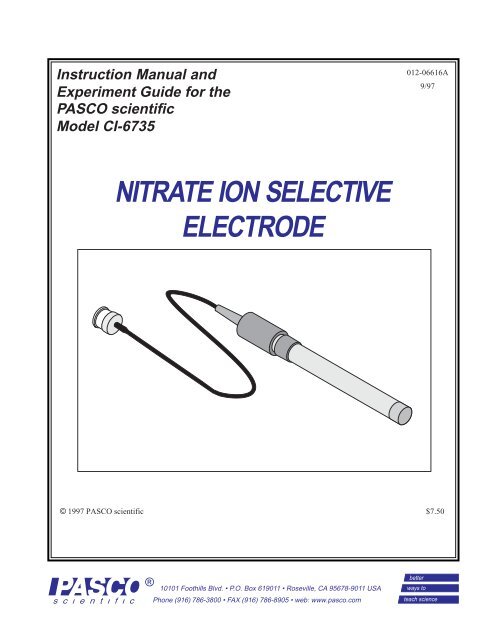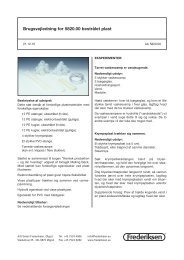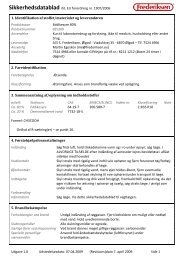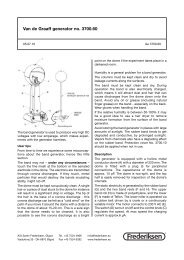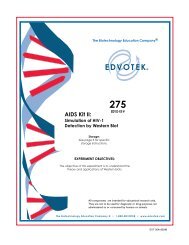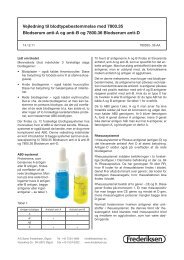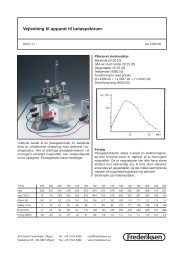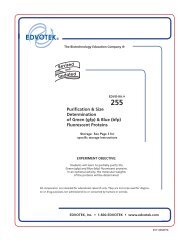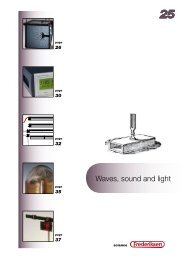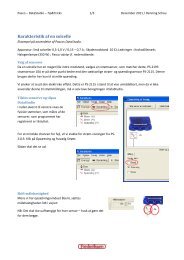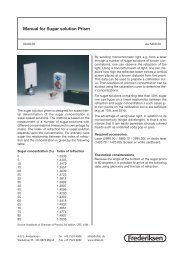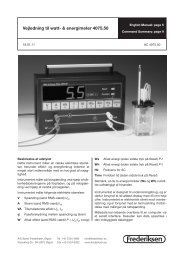NITRATE ION SELECTIVE ELECTRODE - Frederiksen
NITRATE ION SELECTIVE ELECTRODE - Frederiksen
NITRATE ION SELECTIVE ELECTRODE - Frederiksen
You also want an ePaper? Increase the reach of your titles
YUMPU automatically turns print PDFs into web optimized ePapers that Google loves.
012–06616A Nitrate Ion Selective ElectrodeTable of ContentsIntroduction......................................................................................................................................... 1Theory .................................................................................................................................................. 1Equipment ........................................................................................................................................... 3Included: ....................................................................................................................................... 3Additional Required: .................................................................................................................... 3Required Solutions.............................................................................................................................. 3General Preparation ........................................................................................................................... 4Electrode Preparation.................................................................................................................... 4Electrode Slope Check Using ScienceWorkshop .......................................................................... 4Measurement ....................................................................................................................................... 5Measuring Hints............................................................................................................................ 5Sample Requirements ................................................................................................................... 5Units of Measurement................................................................................................................... 5Measurement Procedure .................................................................................................................... 6Direct Measurement...................................................................................................................... 6Low Level Nitrate Determination ................................................................................................. 7Electrode Characteristics ................................................................................................................... 9Reproducibility ............................................................................................................................. 9Interferences.................................................................................................................................. 9Temperature Influences............................................................................................................... 10Electrode Response ..................................................................................................................... 10Limits of Detection ..................................................................................................................... 11pH Effects ................................................................................................................................... 11Electrode Life ............................................................................................................................. 11Maintenance ...................................................................................................................................... 12Electrode Storage ........................................................................................................................ 12Specifications..................................................................................................................................... 12Troubleshooting Guide ..................................................................................................................... 12Glassware/Plastic-ware ............................................................................................................... 12Electrode ..................................................................................................................................... 12Standards & Reagents ................................................................................................................. 13Sample ........................................................................................................................................ 13Technique .................................................................................................................................... 13Troubleshooting Hints ...................................................................................................................... 14Technical Support ............................................................................................................................. 17i
Copyright, Warranty, and Equipment ReturnPlease—Feel free to duplicate this manualsubject to the copyright restrictions below.Copyright NoticeThe PASCO scientific 012-06616A manual iscopyrighted and all rights reserved. However,permission is granted to non-profit educationalinstitutions for reproduction of any part of the NitrateIon Selective Electrode manual providing thereproductions are used only for their laboratories andare not sold for profit. Reproduction under any othercircumstances, without the written consent of PASCOscientific, is prohibited.Limited WarrantyPASCO scientific warrants the product to be free fromdefects in materials and workmanship for a period ofone year from the date of shipment to the customer.PASCO will repair or replace at its option any part ofthe product which is deemed to be defective inmaterial or workmanship. The warranty does notcover damage to the product caused by abuse orimproper use. Determination of whether a productfailure is the result of a manufacturing defect orimproper use by the customer shall be made solely byPASCO scientific. Responsibility for the return ofequipment for warranty repair belongs to thecustomer. Equipment must be properly packed toprevent damage and shipped postage or freightprepaid. (Damage caused by improper packing of theequipment for return shipment will not be covered bythe warranty.) Shipping costs for returning theequipment after repair will be paid by PASCOscientific.CreditsAuthor: Peter BoyleEditor: Steve MillerEquipment ReturnShould the product have to be returned to PASCOscientific for any reason, notify PASCO scientific byletter, phone, or fax BEFORE returning the product.Upon notification, the return authorization andshipping instructions will be promptly issued.ä NOTE: NO EQUIPMENT WILL BEACCEPTED FOR RETURN WITHOUT ANAUTHORIZAT<strong>ION</strong> FROM PASCO.When returning equipment for repair, the units mustbe packed properly. Carriers will not acceptresponsibility for damage caused by improperpacking. To be certain the unit will not be damaged inshipment, observe the following rules:➀ The packing carton must be strong enough for theitem shipped.➁ Make certain there are at least two inches of packingmaterial between any point on the apparatus and theinside walls of the carton.➂ Make certain that the packing material cannot shift inthe box or become compressed, allowing theinstrument come in contact with the packing carton.Address:PASCO scientific10101 Foothills Blvd.P.O. Box 619011Roseville, CA 95678-9011Phone: (916) 786-3800FAX: (916) 786-3292email: techsupp@pasco.comweb: www.pasco.comii
012–06616A Nitrate Ion Selective ElectrodeIntroductionThe PASCO scientific Nitrate Ion Selective Electrode is used to quickly, simply, accurately, and economicallymeasure nitrate in aqueous solutions.TheoryThe Nitrate Ion Selective Electrode consists of an electrode body containing a liquid internal filling solution incontact with a gelled organophilic membrane containing a nitrate ion exchanger. When the membrane is in contactwith a solution containing free nitrate ions, an electrode potential develops across the membrane. This electrodepotential is measured against a constant reference potential, using an ISE Amplifier and ScienceWorkshop Interface.The level of nitrate ions, corresponding to the measured potential, is described by the Nernst equation:where:E = E 0 – S log XE = measured electrode potentialE 0 = reference potential (a constant)S = electrode slope ( ≈ 55decade mV )X = level of nitrate ions in solutionThe activity, X, represents the effective concentration of the ions in solution. The total nitrate ion concentration,C tis the sum of free nitrate ion, C ƒ, and complexed or bound perchlorate ion, C b. The electrode is able to respondto only the free ions, whose concentration isC f = C t = C bSince nitrate ions form very few stable complexes, the free ion concentration may be equated to the total ionconcentration.The activity is related to the free ion concentration, C ƒ, by the activity coefficient, γ, by:X = γ C fActivity coefficients vary, depending on total ions strength, I, defined as:I = 1 2 ΣC XZ X 21
Nitrate Ion Selective Electrode 012–06616Awhere:C X = concentrationof ion XZ X = charge of ion XΣ = sum of all of the types of ions in the solutionIn the case of high and constant ionic strength relative to the sensed ion concentration, the activity coefficient, γ ,is constant and the activity, X, is directly proportional to the concentration.To adjust the background ionic strength to a high end constant value, ionic strength adjuster (ISA) is added tosamples and standards. The recommended ISA for nitrate is (NH 4) 2S0 4. Solutions other than this may be used asionic strength adjusters as long as ions that they contain do not interfere with the electrode’s response to nitrate ions.Strongly acidic (pH = 0 - 2) and strongly basic (pH = 12 - 14) solutions are particularly troublesome to measure.The high mobility of hydrogen and hydroxide ions in samples make it impossible to mask their effect on the junctionpotential with any concentration of equitransferent salt. One must either calibrate the electrode in the same pH rangeas the sample or use a known incremental method for ion measurement.2
012–06616A Nitrate Ion Selective ElectrodeEquipment• Nitrate Ion Selective Electrode• Nitrate Ion Selective Electrode fill solution• Pipette for fill solutionAdditional Required:Required EquipmentPASCO CI-6738 ISE (Ion Selective Electrode)Amplifierto ISEAmplifierSodium Ion SelectiveElectrodeROO1013Reference Fi4MKCISAMPLEl Solution• ScienceWorkshop 2.2.5 or higher• PASCO ScienceWorkshop ComputerInterface• Semi-logarithmic 4-cycle graph paperfor preparing calibration curves.• Magnetic stir plate• Lab-ware made of plastic, not glass, forall low level measurementsRequired Solutionsfilling pipetteFigure 1.Included EquipmentfillingsolutionThe stock solutions listed in this section may becreated as described in the text or ordered directlyfrom PASCO. The solutions available for order,and their respective prices are listed on the ‘ISEWorking Solution Price List’.• Deionized or distilled water for solution and standard preparation• Ionic Strength Adjuster (ISA) , 2 M (NH 4) 2SO 4To prepare this solution, half fill a 1,000 ml volumetric flask with distilled water and add 264 grams ofreagent-grade ammonium sulfate, (NH 4) 2S0 4. Swirl the flask gently to dissolve the solid. Fill the flask tothe mark with distilled water, cap, and upend several times to mix the contents. ISA is added at the rate of2 ml of ISA to each 100 ml of standard or sample to adjust the ionic strength to about 0.12 M.• Reference Filling Solution, 0.l M (NH 4) 2SO 4/0.0l M KCl• Nitrate Standard, 0.1 M NaNO 3To prepare this solution, add 8.50 grams of reagent-grade sodium nitrate to a one liter volumetric flask abouthalf full of distilled water. Swirl the flask gently to dissolve the solid. Fill to the mark with distilled water,cap, and upend several times to mix the solution.-1• Nitrate Standard, 1,000 ppm NO 3To prepare this solution, add 1.37 grams of reagent-grade sodium nitrate to a one liter volumetric flask abouthalf full with distilled water. Swirl the flask gently to dissolve the solid. Fill to the mark with distilled water,cap, and upend several times to mix the solution.-1• Nitrate Standard, 100 ppm NO 3To prepare this solution, add 0.61 grams of reagent-grade sodium nitrate to a one liter volumetric flask abouthalf full with distilled water. Swirl the flask gently to dissolve the solid. Fill to the mark with distilled water,cap, and upend several times to mix the solution.3
Nitrate Ion Selective Electrode 012–06616AGeneral PreparationElectrode Preparation1. Remove the rubber cap covering the electrode tip. Slidethe rubber sleeve down away from the filling hole of theNitrate Ion Selective Electrode. Fill the electrode withthe included filling solution to a level just below the fillhole. Slide the rubber sleeve back over the filling hole(Figure 2a). Gently shake the electrode downward in thesame manner as a clinical thermometer to remove any airbubbles that may be trapped behind the nitrate membrane.Prior to first usage, or after long term storage, immersethe nitrate membrane in nitrate standard for thirty minutes.The electrode is now ready for use.2. Connect the Nitrate Ion Selective Electrode to the ISEAmplifier and insert the DIN connector of the ISEAmplifier into analog port A or B on a PASCO ComputerInterface (Figures 2b and 2c).abfill holerubbersleeverubber capInsert DINconnector intoanalog channelA or B.Electrode Slope Check Using Science Workshop(check electrodes each day)1. To a 150 ml glass beaker, add 100 ml of distilled waterand 2 ml of ISA. Place the beaker on a magnetic stirrerand begin stirring at a constant rate. Start theScienceWorkshop software, select the Ion SelectiveElectrode sensor, open a Digital display, change thenumber of digits to the right of the decimal from 1 to 3,and begin monitoring data. Lower the electrode tip intothe solution.2. Using a pipette, add 1 ml of 0.l M or 1,000 ppm nitratestandard to the beaker. When the reading has stabilized,record the voltage reading indicated in the Digits display.cRotate ringone-quarterturn to secureelectrodeconnectorISE AmplifierFigure 2Equipment Setup. a: filling the electrodewith filling solution; b & c: connecting theelectrode to the ISE Amplifier and to thecomputer interface3. Using a pipette, add 10 ml of the same nitrate standard used above to the beaker. When the reading hasstabilized, record the voltage reading indicated in the Digits display.4. Determine the difference between the two readings. A difference of 55 ±2 mV indicates correct electrodeoperation assuming the solution temperature is between 20 °C and 25 °C. See the Troubleshootingsections if the potential change is not within this range.ä Note: Slope is defined as the change in potential observed when the concentrationchanges by a factor of 10.4
012–06616A Nitrate Ion Selective ElectrodeMeasurementMeasuring Hints• All samples and standards should be at the same temperature for precise measurement. A difference of 1 °Cin temperature will result in a 2% measurement error.• The sensing membrane is normally subject to water uptake and might appear milky. This has no effect onperformance.• Constant, but not violent, stirring is necessary for accurate measurement. Magnetic stirrers can generatesufficient heat to change the solution temperature. To counteract this effect, place a piece of insulatingmaterial, such as Styrofoam sheet, between the stirrer and beaker.• Always rinse the electrode with distilled water and blot dry between measurements. Use a clean, dry tissueto prevent cross-contamination.• For samples with high ionic strength, prepare standards whose composition is similar to the sample.• Always check to see that the membrane is free from air bubbles after immersion into standard or sample.• A slow responding electrode may be caused by interferences to the electrode. To restore properperformance, soak the electrode in distilled water for about 5 minutes to clean the membrane, rinse, and soakin standard solution for about 5 minutes.Sample Requirements• All samples must be aqueous and not contain organics which can dissolve in the membrane or extract outthe liquid ion exchanger.• The temperature of the standard solutions and of the sample solutions should be the same and below 40 °C.About a 2% error will be introduced for a l °C difference in temperature.• Interference’s should be absent. If they are present, use the procedures found in the Interference’s sectionto remove them.• The pH range for the nitrate ion electrode is 2.5 - 11. Neutralize samples outside this range with acid or baseto bring them in range.Units of MeasurementNitrate concentrations are measured in units of ppm as sodium nitrate, ppm as nitrate, moles per liter, or any otherconvenient concentration unit. Table 1 indicates some of the concentration units.TABLE 1. Concentration Unit Conversion Factors-1ppm NaNO 3ppm NO 3moles/liter850.00 620.00 1.0 X 10 -285.0 62.0 1.0 X 10 -38.5 6.2 1.0 X 10 -45
Nitrate Ion Selective Electrode 012–06616AMeasurement ProcedureDirect MeasurementDirect measurement is a simple procedure for measuring a large number of samples. A single reading is all that isrequired for each sample. The ionic strength of samples and standards should be made the same by adjustment withISA for all nitrate solutions. The temperature of both sample solution and standard solutions should be the same.Direct MeasurementäNote: A calibration curve is constructed on semilogarithmic paper. The measuredelectrode potential (linear axis) is plotted against the standard concentration (log axis). Inthe linear region of the curve, only two standards are necessary to determine a calibrationcurve. Calibration solutions close to the anticipated value of the “unknown” should bechosen. In the nonlinear region, additional points must be measured. The directmeasurement procedures given are for the linear portion of the curve. The nonlinearportion of the curve requires the use of low level procedures.1. By serial dilution, prepare three standard solutions from the 0.l M or 1,000 ppm stock standard. Theresultant concentrations should be l0 -2 , l0 -3 , and 10 -4 M or 1,000, 100 and 10 ppm nitrate standards. Add2 ml of ISA to each 100 ml of standard. Prepare standards with a composition similar to the samples ifthe samples have an ionic strength above 0.l M2. Place the most dilute solution (l0 -4 M or 10 ppm) in a 150 ml beaker on the magnetic stirrer and beginstirring at a constant rate. After assuring that ScienceWorkshop is operating, lower the electrode tip intothe solution. After the reading has stabilized, record the Voltage reading in the Digits Display.3. Place the mid-range solution (l0 -3 N or 100 ppm) in a 150 ml beaker on the magnetic stirrer and beginstirring. After rinsing the electrode with distilled water, blot dry and immerse the electrode tip in thesolution. When the reading has stabilized, record the Voltage reading in the Digits Display.4. Place the most concentrated solution (l0 -2 M or 1,000 ppm) in a 150ml beaker on the magnetic stirrer andbegin stirring. After rinsing the electrode in distilled water, blot dry, and immerse the electrode tip in thesolution. When the reading has stabilized, record the Voltage reading in the Digits Display.5. Using the semi-logarithmic graph paper, plot the Voltage reading in the Digits Display (linear axis)against the concentration (log axis). Extrapolate the calibration curve down to about l.0X10 -5 M (1.0 ppmNO 3 -1 ). A typical calibration curve can be found in Figure 3.6
012–06616A Nitrate Ion Selective Electrode+30+70electrodepotential(mV)+110+150+190~56mV10-fold change+2300.1 1 10 100 1,000(ppm as NO 3)(ppm as N)0.11 10 100 1,00010 -6 10 -5 10 - 4 10 -3 10 -2-1NO 3concentration (M)Figure 3Typical nitrate electrode calibration curveä Note: A calibration curve is constructed on semi-logarithmic paper The measuredelectrode potential in (linear axis) is plotted against the standard concentration (log axis).In the linear region of the curve, only three standards are necessary to determine acalibration curve. In the non-linear region, additional points must be measured. The directmeasurement procedures given are for the linear portion of the curve. The non-linearportion of the curve requires the use of low level procedures.6. To a clean, dry 150 ml beaker, add 100 ml of the sample and 2 ml of ISA. Place the beaker on the magneticstirrer and begin stirring at a constant rate. Rinse the electrode tip with distilled water, blot dry, and lowerthe electrode tip into the solution. When the reading has stabilized, record the Voltage reading in the DigitsDisplay. Using the calibration curve, determine the sample concentration.7. The calibration should be checked every two hours. Assuming no change in ambient temperature, placethe electrode tip in the mid-range standard. After the reading has stabilized, compare it to the originalreading recorded in step 3 above. A reading differing by more than 0.5mV or a change in the ambienttemperature will necessitate the repetition of steps 2 - 6 above. A new calibration curve should beprepared daily.Low Level Nitrate MeasurementsThis procedure is recommended for solutions with ionic strengths less than l.0Xl0 -4 M. If the solution is high in ionicstrength, but low in nitrate, use the same procedure, but prepare a calibration solution with a composition similarto the sample.1. Using 20 ml of standard ISA, dilute to 100 ml with distilled water. This low level ISA [0.4 M (NH 4) 2SO 4]is added at the rate of 1 ml low level ISA to each 100 ml of sample. The background ionic strength willbe 4.0X l0 -3 M.10 -17
Nitrate Ion Selective Electrode 012–06616A2. Dilute 1 ml of 0.l M standard to 100 ml to prepare a l.0Xl0 -3 M NO 3 -1 solution for measurements in molesper liter. Use the 1,000 ppm standard for preparing a 100 ppm NO 3 -1 standard by diluting 10 ml of the1,000 ppm standard to 100 ml. Standards should be prepared fresh daily.3. Add 1 ml of the low level ISA to a 100 ml volumetric flask and fill to the mark with distilled water. Pourthis solution into a 150 ml beaker and place the beaker on the magnetic stirrer. Begin stirring at a constantrate.4. Place the electrode tip in the solution. Assure that ScienceWorkshop is operating.5. Add increments of the l.0Xl0 -3 M or 100 ppm standards as given in Table 2 below.6. After the reading has stabilized, record the Voltage reading in the Digits Display after each addition.TABLE 2: Step-wise Calibration for Low Level Nitrate MeasurementsAddedConcentration-1-1Step Pipette Volume (mL) M NO 3ppm NO 31 A 0.1 1.0 X 10 -6 0.12 A 0.1 2.0 X 10 -6 0.23 A 0.2 4.0 X 10 -6 0.44 A 0.2 6.0 X 10 -6 0.65 A 0.4 9.9 X 10 -6 1.06 B 2.0 2.9 X 10 -5 2.97 B 2.0 4.8 X 10 -5 4.8Pipette A = 1 ml graduated pipettePipette 8 = 2 ml pipetteSolutions: additions of l.0X10 -3 M or 100 ppm standard to 100 ml of ISA as prepared in step 3 above.7. On semi-logarithmic graph paper, plot the voltage reading on the Digits display (linear axis) against theconcentration (log axis) as in Figure 3.8. Rinse the electrode and blot dry.9. Measure out 100 ml of the sample into a 150 ml beaker, add 1 ml of low level ISA. Place the beaker onthe magnetic stirrer and begin stirring. Lower the electrode tip into the solution. After the reading hasstabilized, record the Voltage reading indicated in the Digits Display and determine the concentrationfrom the low level calibration curve.10.Prepare a new low level calibration curve daily. Check the calibration curve every two hours by repeatingsteps 2 - 7.8
Nitrate Ion Selective Electrode 012–06616AThe above interference removal procedures require similar treatment of standards as well as samples.If the electrode is exposed to high levels of interfering ions which cannot be removed, the electrode reading maydrift and the response may become sluggish. Restore performance by soaking in distilled water for 30 minutesfollowed by soaking in nitrate standard for 30 minutes.Temperature InfluencesSamples and standards should be at the same temperature, since electrode potentials are influenced by changes intemperature. A l °C difference in temperature results in a 2% error at the l0 -3 M level. Because of the solubilityequilibria on which the electrode depends, the absolute potential of the reference electrode changes slowly withtemperature. The slope of the nitrate electrode, as indicated by the factor “S’ in the Nernst equation, also varies withtemperature. Table 4 gives values for the “S” factor in the Nernst equation for the nitrate ion.The operating range of the nitrate ion electrode is 0 °C - 40 °C, provided that temperature equilibrium has occurred.If the temperature varies substantially from room temperature, equilibrium times up to one hour are recommended.TABLE 4: Temperature vs. Theoretical Values for the Electrode SlopeTemperature ( ºC)“S”0 54.2010 56.1820 58.1625 59.1630 60.1540 62.1350 64.11Electrode ResponsePlotting the electrode potential against the nitrate concentration on semi-logarithmic paper results in a straight linewith a slope of about 55 mV/decade. (Refer to Figure 3.)The time needed to reach 99% of the stable electrode potential reading, the electrode response time, varies fromone minute or less in highly concentrated solutions to several minutes near the detection limit. (Refer to Figure 4.)10
012–06616A Nitrate Ion Selective Electrode+50+7510 -3 M to 10 -2 M NaNO 3electrodepotential(mV)+100+125+150+175+200+22510 -3 M to 10 -4 M NaNO 310 -3 M to 10 -5 M NaNO 310 -3 M to 10 -6 M NaNO 31 2 3 4time (minutes)Figure 4Typical electrode time response to step changes in NaNO3Limits of DetectionThe upper limit of detection in pure sodium nitrate solutions is 1 M. In the presence of other ions, the upper limitof detection is above l0 -1 M nitrate, but two factors influence this upper limit. Both the possibility of a liquid junctionpotential developing at the reference electrode and the malt extraction effect influence this upper limit. Some saltsmay infuse into the electrode membrane at high salt concentrations, causing deviation from the theoretical response.Either dilute samples between 1 M and l0 -1 M or calibrate the electrode at 4 or 5 intermediate points.The lower limit of detection is influenced by the slight water solubility of the ion exchanger used in the sensingportion of the electrode. Refer to Figure 3 for a comparison of the theoretical response to the actual response at lowlevels of nitrate. Nitrate measurements below l0 -5 M NO 3 -1 (0.6 ppm as N0 3 -1 ) should employ low level procedures.pH EffectsThe operating range of the nitrate electrode is from pH 2.5 to pH 11.Electrode LifeThe nitrate electrode will last six months in normal laboratory use. On-line measurement might shorten operationallifetime to several months. In time, the response time will increase and the calibration slope will decrease to the pointcalibration is difficult and electrode replacement is required.11
Nitrate Ion Selective Electrode 012–06616AMaintenanceElectrode StorageThe nitrate electrode may be stored for short periods of time in l0 -2 M nitrate solution. For longer storage (longerthan two weeks), rinse and dry the nitrate membrane and cover the tip with any protective cap shipped with theelectrode. The reference portion of the combination electrode (or the outer chamber of the reference electrode)should be drained of filling solution, if refillable and the rubber insert placed over the filling hole.SpecificationsTroubleshooting GuideConcentration Range: 1 M to 7X10 -6 M (6.2X10 4 to 0.5 ppm as NO -1 3)pH Range: 2.5 to 11Temperature Range: 0 °C – 40 °CResistance:100M ohmsReproducibility: ±2%Samples:aqueous solutions only, no organic solventsStorage:store in dilute nitrate solutionSize:110 mm length12 mm diametercable length = 1 mThe goal of troubleshooting is the isolation of a problem through checking each of the system components in turn:the meter, the plastic-ware, the electrode, the standards & reagents, the sample, and the technique.Glassware/Plastic-wareClean glassware is essential for good measurement. Be sure to wash the glassware/plastic-ware well with a milddetergent and rinse very well with distilled or deionized water.ElectrodeThe electrode may be checked by using the procedure found in the sections entitled Electrode Slope Check.1. Be sure to use distilled or deionized water when following the procedures given in Electrode SlopeCheck.2. If the electrode fails to respond as expected, see the section Measuring Hints. Repeat the slope check.3. If the electrode still fails to respond as expected, substitute another Nitrate Ion Selective Electrode (ifavailable) that is known to be in good working order for the questionable electrode. If the problem persistsand you are using an electrode pair, try the same routine with a working reference electrode.12
012–06616A Nitrate Ion Selective Electrode4. If the problem persists, the standards or reagent may be of poor quality, interferences in the sample maybe present or the technique may be faulty. (See Standards Reagents, Sample, and Technique sectionsbelow.)5. If another electrode is not available for test purposes, or if the electrode in use is suspect, review theinstruction manual and be sure to:- Clean and rinse the electrode thoroughly.- Prepare the electrode properly.- Use the proper filling solution.- Adjust the pH and the ionic strength of the solution by the use of the proper ISA.- Measure correctly and accurately.- Review Troubleshooting Hints.Standards & ReagentsWhenever problems arise with the measuring procedure that has been used successfully in the past, be sure to checkthe standard and reagent solutions. If in doubt about the credibility of any of the solutions, prepare them again. Errorsmay result from contamination of the ISA, incorrect dilution of standards, poor quality distilled/deionized water,or a simple mathematical miscalculation.SampleLook for possible interferences, complexing agents, or substances which could affect the response or physicallydamage the sensing electrode if the electrode works perfectly in the standard, but not in the sample.Try to determine the composition of the samples prior to testing to eliminate a problem before it starts. (SeeMeasuring Hints, Sample Requirements, and Interferences.)TechniqueBe sure that the electrode’s limit of detection has not been exceeded. Be sure that the analysis method is clearlyunderstood and is compatible with the sample. Refer to the instruction manual again. Reread General Preparationand Electrode Characteristics.If trouble still persists, call PASCO scientific Technical Support.13
Nitrate Ion Selective Electrode 012–06616ATroubleshooting HintsSymptom Possible Causes Next StepOut of Range Reading defective electrode check electrode operationelectrodes not plugged inproperlyreference electrode not filledair bubble on membraneelectrode not in solutionunplug electrodes and reseat electrodesbe sure reference electrode is filledremove bubble by re-dipping electrodeput electrodes in solutionNoisy or Unstable electrode exposed to interferences soak electrode in nitrate standardReadings (readingscontinuously or rapidly defective electrode replace electrodechanging)ISA not useduse recommended ISAstirrer not groundedair bubble on membraneouter filling solution level too lowground stirrerremove bubble by re-dipping electrodefill electrode to level just below the fill holeDrift (reading slowly samples and standards at different allow solutions to come to room temperaturechanging in one direction) temperatures before measurementelectrode exposed to interferencesincorrect reference filling solutionsoak electrode in nitrate standarduse recommended filling solution14
012–06616A Nitrate Ion Selective ElectrodeSymptom Possible Causes Next StepLow Slope or No Slope standards contaminated or prepare fresh standardsincorrectly madeISA not usedstandard used as ISAelectrode exposed to interferencesdefective electrodeair bubble on membraneuse recommended ISAuse ISAsoak electrode in nitrate standardcheck electrode operationremove bubble by re-dipping probe“Incorrect Answer” incorrect scaling of semilog paper plot voltage potential on the linear axis.(but calibration curveOn the log axis, be sure concentrationis good)numbers within each decade are increasingwith increasing concentration.incorrect signincorrect standardswrong units usedsample carryoverbe sure to note sign of millivolt readingcorrectlyprepare fresh standardsapply correct conversion factor:10 -3 M = 62.0 ppm as NO 3-110 -3 M = 85.0 ppm as NaNO 3rinse electrode thoroughly between samples15
Nitrate Ion Selective Electrode 012–06616A16
Technical SupportFeedbackIf you have any comments about the product ormanual, please let us know. If you have anysuggestions on alternate experiments or find a problemin the manual, please tell us. PASCO appreciates anycustomer feedback. Your input helps us evaluate andimprove our product.To Reach PASCOFor technical support, call us at 1-800-772-8700(toll-free within the U.S.) or (916) 786-3800.fax: (916) 786-3292e-mail:web:techsupp@pasco.comwww.pasco.comContacting Technical SupportBefore you call the PASCO Technical Support staff,it would be helpful to prepare the followinginformation:➤ If your problem is with the PASCO apparatus,note:- Title and model number (usually listed on thelabel);- Approximate age of apparatus;- A detailed description of the problem/sequence of events (in case you can’t callPASCO right away, you won’t lose valuabledata);- If possible, have the apparatus within reachwhen calling to facilitate description ofindividual parts.➤ If your problem relates to the instruction manual,note:- Part number and revision (listed by month andyear on the front cover);- Have the manual at hand to discuss yourquestions.


